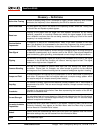
38 www.seektech.com Ridge Tool Company Elyria, Ohio U.S.A
SeekTech SR-60
be able to make the correct decision rapidly and
accurately.
A Better Way of Locating
The SR-60 gives the operator a picture of the
situation as the receiver moves along the target area
and makes it easier to understand where a target
line’s electromagnetic field is. With more complete
information, an operator can understand how things
stand underground and resolve complex situations,
avoid inaccurate mark-ups, and find the right line or
cable more rapidly.
What the SR-60 Does
The SR-60 is used above ground to sense and trace
electromagnetic fields emitted from underground or
hidden lines (electrical conductors like metal cables
and pipes) or Sondes (actively transmitting beacons).
When the fields are undistorted, the information from
the sensed fields gives an accurate picture of the
buried object. When the situation is made complex by
interference from more than one line, or other factors,
the SR-60 provides a display of information that
shows multiple measurements of the detected field.
This data can make it easier to understand where the
problem is, by providing clues as to whether a locate
is good or bad, questionable or reliable. Instead of
just laying paint in the wrong place, the operator can
see clearly when a difficult locate needs re-
evaluation.
The SR-60 provides more of the critical information
the operator needs to understand the situation
underground.
What It Does Not Do
The SR-60 locates by sensing electromagnetic fields
surrounding conductive objects; it does not sense the
underground objects directly. It provides more
information about the shape, orientation, and
direction of fields than other locators but it does not
magically interpret that information or provide an x-
ray image of underground objects.
A distorted, complex field in a noisy environment
requires intelligent human thought to analyze
correctly. The SR-60 cannot change the results of a
difficult locate, even though it shows all the
information about those results. Using what the SR-
60 shows, a good operator can improve locating
results by “making the circuit better”, changing
frequency, grounding or the transmitter’s location on
the target line.
Advantages of the Omnidirectional
Antenna
Unlike the coils used in many simple locator devices, the
Omnidirectional antenna detects fields on three separate
axes, and can combine these signals into a “picture” of
the apparent strength, orientation, and direction of the
complete field. Omnidirectional antennas offer definite
advantages:
The Mapping Display
The mapping display enabled by the Omnidirectional
antennas provides a graphic view of a signal’s
characteristics and a bird’s eye view of the signal from
underground. It is used as a guide for tracing
underground cables and pipes, and can be used to
better pinpoint Sondes. It can also be used to provide
more information for complex locates.
Figure 69: Mapping Display
The use of lines (representing the signals sensed by
upper and lower antennas) and guidance arrows
(pointing toward the center of the detected field) combine
to give the locator a graphic picture of the receiver’s
location, and where the target utility or Sonde is. At the
same time the operating screen provides all the
information needed to understand what is happening
with the field being located – its Signal Strength,
continuous distance, Signal Angle, and proximity to the
target. The information available at one moment on the
SR-60 would take multiple sample readings with some
conventional locators. A distorted or compound field will
be easier to interpret when all the information is in a
single display as it is with the SR-60.


















